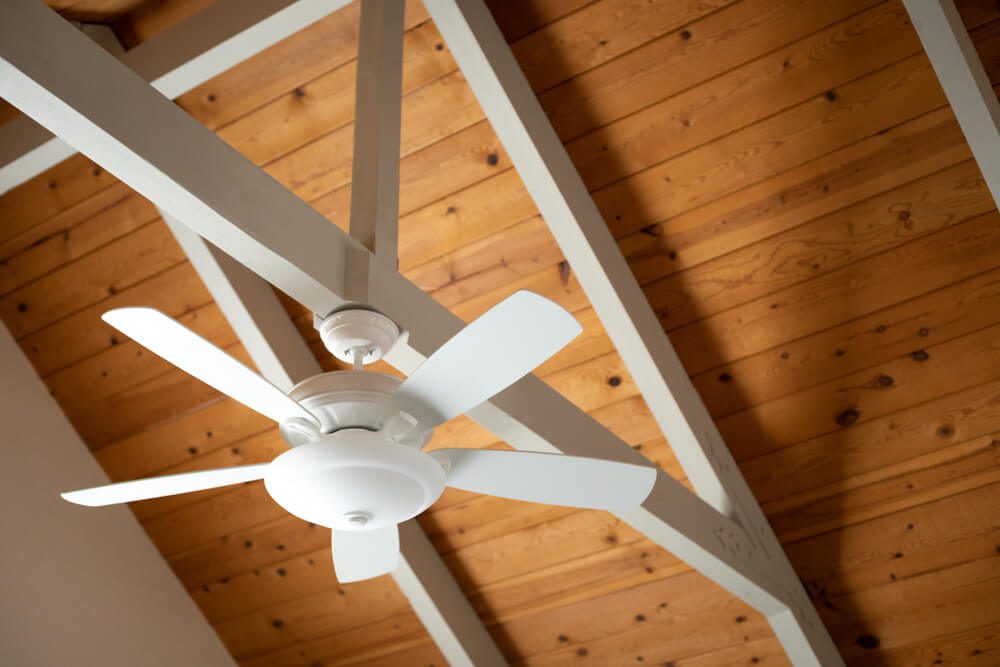Blog
Does Ceiling Fan Direction Matter?

A surprising number of homeowners do not realize that ceiling fans are bi-directional. A switch, remote control button, or cord typically controls the direction in which the fan blades rotate.
The direction a ceiling fan spins does matter. All fans move air around the room, but the direction of the ceiling fan should change based on the weather. Here’s how to correctly orient your ceiling fan direction by season.
Ceiling Fan Direction for Summer
In hot weather, the ceiling fan should blow air straight down. This pushes air down on the room's occupants and creates a small-scale “chill factor” that makes a windy day feel cooler than a calm one.
Molecules naturally want to share heat equally among themselves, though some materials transfer heat faster or slower than others. When air hits you, your body heat is usually warmer than it is, and heat is transferred from you to the air molecule. Fans push air so that significantly more air molecules hit you than would normally in a still room. This increases the transfer of heat, effectively cooling you down.
Turning on the ceiling fan lets you cool off, and even allows you to set the AC thermostat a few degrees higher. By doing so, you can save on energy bills.
How to Set Your Ceiling Fan Direction for Summer
First, you must determine which direction your fan is turning. For summer, your fans should be rotating in the “counter-clockwise” direction or “summer” setting. Turn your fan on the lowest speed setting and see which direction it turns.
The method for changing the ceiling fan direction will depend on the model. If your fan has a remote control, check that first. Some fans have a small, black switch on the base of the fan model. Finally, some fans will have a short hanging cord, separate from the light or fan cords.
Ceiling Fan Direction For Winter

During the winter, it’s colder, and your heater is blowing warm air into the house. The hot air will naturally rise above the cold air, making it feel cold. A fan isn’t only for use in the summertime. During the winter, it can be used to push the risen hot air down where people are and mix it with the cold air.
Ceiling fans push the air molecules around and improve heat distribution, forcing the warm air to mix properly around the room.
Set the ceiling fan to a “clockwise” or “winter” setting so that the fan draws air from the room below and pushes it up to the ceiling. As air passes through the fan and is pushed across the ceiling, it displaces the layers of hot air at the top, forcing them downward and mixing the various layers of air.
How to Set Your Ceiling Fan Direction for Winter
The directions for setting your ceiling fan for winter is the same as for summer, except the opposite direction. Turn the fan on to low and see if the blades are rotating clockwise. If they are not rotating clockwise, you must find the switch, button, or cord to change the direction.
Let the fan stop spinning, and then activate the switch or button. Then, turn your fan back on for your winter setting.
Do Ceiling Fans Help If No One is in the Room?
Ceiling fans only enhance heating or cooling for occupants. If no people or pets are in a room, then there is no benefit from running the fan. Fans merely distribute hot or cold air more evenly throughout a room. Turn ceiling fans in unoccupied rooms off.
Expert Ceiling Fan Installation & Repair in Cincinnati
If your ceiling fan isn’t switching directions, won’t turn on, or you just need a new one installed, Apollo Home can help. We offer expert ceiling fan installations and repairs in or around Cincinnati. Contact us for more information.



